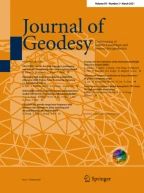Abstract.
Station coordinates are combined with velocities estimated by space geodesy techniques to produce the International Terrestrial Reference System. The input is sets of coordinates and velocities calculated by International Earth Rotation Service analysis centers using space geodesy techniques. The working reference system of individual analysis centers is generally conventionally defined. However, the implications of such processing can have an effect on the resulting combined set. The problem of datum definition as a function of coordinate combinations is reviewed. In particular, the problem of minimum constraints is clearly emphasized and the reference system effect is defined. The goal is to build a process that could be used generally to remove uncertainties in the underlying coordinate system without disturbing the underlying information with additional unnecessary information.
Similar content being viewed by others
Author information
Authors and Affiliations
Additional information
Received: 25 January 1999 / Accepted: 20 September 2000
Rights and permissions
About this article
Cite this article
Sillard, P., Boucher, C. A review of algebraic constraints in terrestrial reference frame datum definition. Journal of Geodesy 75, 63–73 (2001). https://doi.org/10.1007/s001900100166
Issue Date:
DOI: https://doi.org/10.1007/s001900100166
